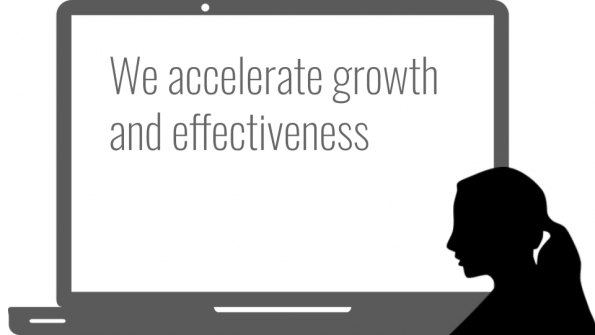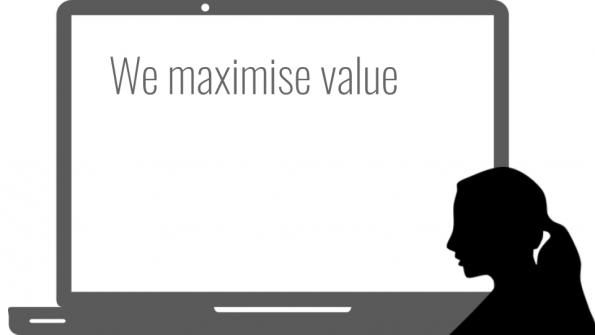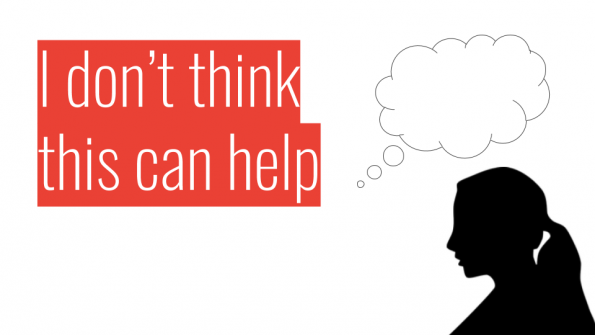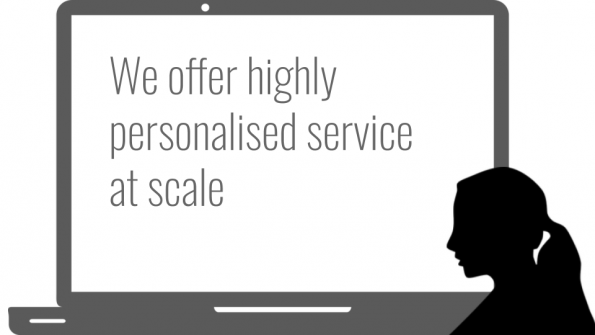You can make conversation, right — in real life? People don’t run away from you or block your calls. They chatter and chortle. And natter and nod. But, online, tech companies can have a hard time speaking about what they do. They primp and proclaim. And baffle and bore.
I took 171 pieces of marketing bumf from one of London’s leading tech conferences and it’s a wince-inducing read. I’ve crudely turned some of it into a real-life conversation and it’s enough to fray your turtleneck sweater.
Customer: “Hey!”
Tech company: “Hello”
Customer: “I’m after some tech…”
Tech company: “We are perfectly timed to meet market demands for a better solution”
Customer: *blinks*
Tech company: “Helping our clients leverage the power of technology”
Customer: “O-kay?”
Tech company: “You get a scalable and secure solution”
Customer: “But does it do what I want it to do?”
Tech company: “It drives strategically important initiatives”
Customer: “OK, but can you tell me why I should buy it?”
Tech company: “It’s accountable and transparent”
Customer: “Ri-ght…”
Tech company: “Harnessing the power of data”
Customer: “And your product makes my life better… how?”
Tech company: “It breaks barriers”
Customer:
And it doesn’t sound any better when it’s written down either.
| 🤖 ChatBot here, how can I help you? |
| 👩💻 Hi, really interested in your new piece of tech… |
| 🤖 You’ll unlock a new route for customers |
| 👩💻 So how does it work? |
| 🤖 By discovering innovative solutions |
| 👩💻 ? |
| 🤖 We empower companies to thrive |
| 👩💻 And can it help me do the thing I need to do right now? |
| 🤖 We have frictionless customer service |
| 👩💻 ? |
| 🤖 And effortless integration |
| 👩💻 … |
| 🤖 Hello? |
When you talk to people in real life, a conversation is a two-way thing. You’re cooperative (I’d hope) so as not to lose them somewhere along the way — a smile here and a nod of recognition there to show you understand their problem and know how to solve it. For them, it’s reassurance they’re in the right place to buy. After all, you might genuinely be able to help them, but that always takes some convincing when you sell online.
When Covid-19 first began to prey on the UK population, our National Cyber Security Centre “took down more than 2,000 online coronavirus scams” in one month. 471 of those were online shops “selling fraudulent virus-related items” reported the BBC. Across the pond, The New York Times said Shopify was busy scrutinising online sellers using their platform to scam people into buying fake or non-existent medical products. They “closed more than 4,500 sites related to the virus” in one week alone.
When the same people that could buy from you are reading grim news like this elsewhere on the internet, you have to go a long way to prove you’re a legitimate seller as well as to prove your product is a worthwhile investment. That’s not so easy when you can’t be face to face.
Online, there are no subtle physical cues that you’re paying attention to the person you’re having a conversation with. There is no visible sign that shows them you’re eager to help. All people have is the sound of your words filling their heads. So unless you write with your customer in mind at all times (not your product), it’s easy to misjudge what they need to hear.
Imagine.
You’re at your desk, writing, surrounded by things that are familiar to you. Not just photos of your life outside of work, but the presentation or pitch you gave yesterday to a potential buyer. Your team is talking about, using, or writing about your product — all day long. And the clients at the end of a video link are already your biggest fans; the people who’ve come to know you more personally and the service that you offer. In this scenario, anything you write about your company feels comfortable and logical.
Simone, on the other hand, has been on hold with her utility company for 45 minutes when she lands on your website. She’s staying home because it’s chucking it down with rain outside and every plan she had for the day is cancelled.
Or she’s in the Bahamas, nestled deep into a sun lounger, trying to avoid the fresh patch of sunlight that forces her to move position to avoid burning her skin.
Who knows where the person is who’s reading about your business right now.
All you know for certain is that ‘Simone’ could be anyone, doing absolutely anything, at any time, whilst reading the words you’ve written to promote what you sell. Your copy has to be clear and it has to be persuasive.
I’d argue that the stuffy, clichéd content I picked up at the tech conference wouldn’t lead to a sale in any scenario. Not even in a conversation that goes on in your own head when you’re browsing the internet for answers.
You’ve lost your reader.
Probably never to return again.
In truth, it doesn’t matter what scenario your reader is in — happy or sad; disgruntled or content. If the conversation is dry, you can quickly lose their interest. But that’s not to say that everything you write has to sound like it’s narrated by David Attenborough. It just has to sound natural.
Conversational copywriting is more Mean Girls than it is A Beautiful Mind
Brian Cox can explain everything about the Higgs boson particle to us non-physicists in three minutes and 22 seconds and we get it. So making your copy conversational or talking less about the complexities of your product isn’t about intelligence or a lack of it. It’s about excluding or alienating your reader, not an unattainable wisdom.
Every business has its jargon. If Brian Cox spoke to me about physics in the same way he speaks to his peers about it, I’d probably pass out from the pain in my furrowed brow. Equally, if you’re not a professional copywriter, it’s of no help if I tell you to strengthen your hook or introduce a golden thread. And as much as it pains me to not describe what those things are, it’s more relevant to leave them hanging. Because that’s exactly what happens to your reader when you use terminology they know nothing about.
- Are you selling to people who work in the exact same field as you do?
- Are you building a community of people who are all just like you?
- Is your technology product world-renowned and fully understood?
In which case, include the jargon words you use so frequently in your everyday conversations. You’re going to attract the right people if you do. But for everything else, can’t we just speak normally? Let’s spare everyone the confusion.
This means not using the words and phrases you sprinkle your copy with because ‘it sounds professional’, ‘is more business-like’, or some such rationale that leads to you sounding like every other business that came before you.
It also means not bamboozling people with detail. So your audience perhaps knows a little about artificial intelligence. They get the pull of AI. But do they know about deep reinforcement learning, really? Talking too much about the mechanics of what you do is the equivalent of getting stuck in the kitchen with the bore of the party, wedged between the fridge and the dustbin, willing someone — anyone — to interrupt and set you free.
People lose interest quickly.
You have to work at keeping a conversation going so your customer sticks around.
Conversational marketing helps ordinary people get to grips with extraordinary ideas
Even if you’re a responsible brand selling sensible products, you can still be conversational. Look at Monzo, living and breathing their ‘banking made easy’ slogan, offering simple saving pots online. Before they came along, banking involved a lot of queueing, form filling, and general tediousness.
That line of theirs about muddling your savings (“no one wants to muddle their savings with their spending money”), in your mind you can hear somebody saying that in a conversation with a cashier who is both friendly and cooperative. You don’t have to be physically present to appreciate the sentiment.
‘It’s all muddled together is it? Well, that’s no good is it. Let’s see what we can do about that.’
It’s not clichéd: “Saving for a rainy day?”
It’s not meh: “Find the right account for you.”
Or dull as an old copper coin you found underneath the fridge: “Anytime access to your money…” 😴
While the emoji dozes off at the end of that last sentence, let’s drop those into this conversation, shall we, because Monzo uses those too. (Sparingly.)
If you think a bank can’t use emojis and be serious as well as successful at the same time, the 4,804,886 people who currently have an account with Monzo could tell you that you’re wrong. According to a YouGov survey in 2019, 84.8% of Monzo’s customers would recommend the banking app to a friend.
That’s more than four million Monzo account holders who couldn’t give a flying money emoji that Monzo will deliberately “swap formal words for normal ones” and “avoid business-speak” to maintain their friendly tone of voice 💸
And what about Habito?
They handle one of the biggest transactions you’re ever likely to make in the whole of your life — buying a house.
Habito started out with the intention to “end mortgage hell forever” and, as anyone who’s ever been through the process of getting one will know, that sounds like heaven.
In only four short years of doing business, Habito has already “sorted £4 billion worth of mortgages”. If people find conversational copy ‘less professional’ somehow, you’d think Habito would have racked up a few million less investments than this because they seem pretty committed to keeping their copy conversational.
I bet at least 3.5 billion doormats most of their customers enjoyed the virtual conversation they had with Habito and maybe even found it a blessed relief after having dealt with traditional mortgage brokers in the past. (Just me?)
Interestingly, the Habito website is certified as “jargon-free” by Fairer Finance who has the exceedingly difficult job of building trust between people and their banks and insurers. It would seem they agree that stuffy sentences and boring business-speak have to go if you want to build stronger relationships with your customers.
Plain speaking is working for Habito.
They’re well on their way to 5,500 Trustpilot reviews and a roof-raising 91% of those people give them the highest possible rating.
All of those people had the same problem. And they trusted in Habito’s plan to fix it.
So how you talk about what you do truly does matter because you can’t sell something without a conversation first. And a greater portion of those conversations are now happening online since Covid-19 accelerated our shift to online spending.
How does your web copy sound?
How to work out how you sound (or want to sound) to others
If you want to do a quick and dirty test to see how your business comes across in conversation, read your home page out loud. Ask yourself if you’d be comfortable saying this to the next person you bump into on the street who asks you what you do.
Does it answer any questions they might have? Because in a real-life conversation you’ll take turns to speak and seek understanding.
Does it sound natural? Because this isn’t a broadcast. People enjoy talking about what interests them, rather than being forced to listen to one-sided dialogue.
There are lots of things you can do to make your copy sound more natural, like recording yourself saying what you want to say instead of writing it down — the result is less formal. Or make notes when you have real-life conversations with your customers to see what words and phrases they use to describe your product and what it does for them.
If you want more conversational copy but you’re not sure where to begin, let me help. I want to banish baffling boffin talk as much as you do.
Avoid sounding like all the other tech companies out there who are alienating or boring their customers.
We can start with a quick-fire analysis of your current copy to see where the conversation falls flat. Re-write any old, bland copy you’re too embarrassed to read out loud. Or completely revamp your image ready for 2021 and the new digital-first era where every conversation counts.
Share this post
Conversational copywriting helps ordinary people get to grips with extraordinary ideas Share on XMain image credit: padrinan on pixabay

Natalie is a copywriter working in AI. She’s creating an immersive exhibition experience for anyone who needs to know: better days will always come 🕯️ More posts
( ´ ∀ `)ノ~ ♡








Thanks for sharing.